Forget-me-nots, with their delicate blue petals and enchanting charm, are a beloved choice for flower lovers and passionate gardeners alike. These perennial beauties not only add a splash of color to any garden but also symbolize lasting love and remembrance. Cultivating forget-me-nots requires a blend of knowledge and care to ensure they thrive and bloom beautifully. In this guide, we will delve into essential tips and techniques for growing forget-me-nots, providing you with all the information you need to nurture these lovely flowers successfully.
Ideal Growing Conditions
Soil Requirements
Forget-me-nots thrive best in moist, well-drained soil rich in organic matter. To prepare the perfect growing medium, consider mixing compost or well-rotted manure into the soil before planting. This will enhance the soil’s nutrient content and improve its texture. Additionally, the soil pH should ideally be slightly acidic to neutral, ranging from 6.0 to 7.0. Regularly check the soil to ensure it remains consistently moist but not waterlogged, as overly soggy conditions can lead to root rot. If your garden soil tends to dry out quickly, adding a layer of mulch can help retain moisture. By providing the right soil conditions, you can create a healthy environment that supports vibrant and bountiful forget-me-not blooms.
Light and Temperature
Forget-me-nots flourish in partial shade to full sun, making them quite adaptable to various garden settings. However, they prefer areas where they receive morning sunlight and afternoon shade. This balance ensures they get enough light for growth while being protected from the intense midday heat. In terms of temperature, forget-me-nots are hardy and can tolerate a range of climates. They perform best in cooler temperatures, ideally between 60°F and 75°F. During extremely hot weather, providing some additional shade can help prevent wilting. Conversely, in colder climates, these flowers can endure light frost but may need protection from severe freezes. By optimizing light and temperature conditions, you can ensure your forget-me-nots remain healthy and vibrant throughout the growing season.
Watering Needs
Proper watering is crucial for the healthy growth of forget-me-nots. These flowers prefer consistently moist soil but do not tolerate waterlogged conditions. To achieve this balance, water your forget-me-nots regularly, especially during dry spells. The soil should be kept evenly moist, but take care to avoid overwatering, which can lead to root rot. A good practice is to water deeply and less frequently rather than lightly and often. This encourages the roots to grow deeper into the soil, enhancing the plant’s overall resilience. During the growing season, monitor the soil moisture and adjust your watering schedule as needed. Using a layer of mulch around the plants can help retain moisture and reduce the frequency of watering. By understanding and meeting their watering needs, you can ensure your forget-me-nots remain lush and vibrant.

Planting and Maintenance
Sowing Forget-Me-Not Seeds
Sowing forget-me-not seeds is a straightforward process that yields beautiful results with proper care. Start by selecting a well-prepared bed with moist, well-drained soil. Scatter the seeds thinly over the soil surface, and lightly press them in without covering them completely, as they need light to germinate. The best time to sow forget-me-not seeds is in early spring or late summer, allowing the plants to establish before extreme weather conditions. After sowing, water the area gently to keep the soil consistently moist but not waterlogged. Germination typically occurs within 1-2 weeks. Once seedlings emerge, thin them to about 6 inches apart to prevent overcrowding and ensure good airflow. Regularly monitor the young plants for any signs of pests or disease. By following these steps, you can successfully establish a thriving bed of forget-me-nots.
Pruning and Deadheading
Pruning and deadheading are important practices to maintain the health and aesthetics of your forget-me-nots. Deadheading, or removing spent flowers, encourages the plant to produce more blooms and prevents it from self-seeding excessively. Use a pair of sharp scissors or garden shears to snip off faded flowers just above a set of healthy leaves. This process not only tidies the plant but also redirects its energy towards new growth. Pruning is typically minimal for forget-me-nots, but it’s essential to remove any yellowing or damaged foliage to promote better air circulation and reduce the risk of disease. At the end of the blooming season, you can cut back the plants to ground level to prepare them for the next growth cycle. Regular deadheading and occasional pruning will keep your forget-me-nots vibrant and flourishing.
Pest and Disease Control
Effective pest and disease control are essential to maintaining healthy forget-me-nots. Common pests that may affect these flowers include aphids, slugs, and snails. Regularly inspect your plants for signs of these pests, such as holes in leaves or sticky residue from aphids. For aphid control, consider using insecticidal soap or introducing beneficial insects like ladybugs. Slugs and snails can be managed by setting up barriers or using organic slug pellets.
In terms of diseases, forget-me-nots are susceptible to powdery mildew and rust. To prevent these fungal infections, ensure good air circulation by spacing plants appropriately and avoiding overhead watering. If you notice signs of disease, such as white powdery spots or orange pustules on leaves, remove affected foliage and apply a fungicide if necessary. By staying vigilant and taking preventive measures, you can protect your forget-me-nots from pests and diseases, ensuring a healthy and vibrant garden.

